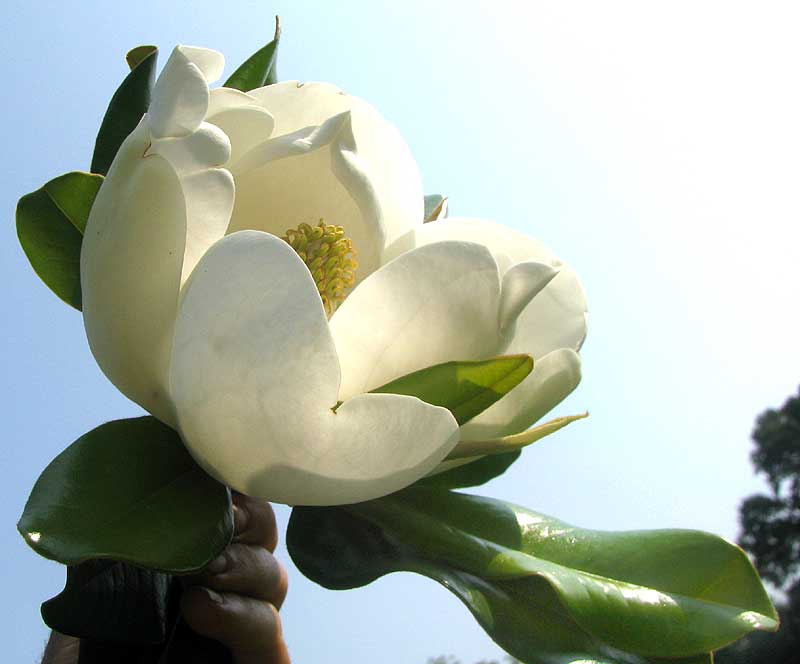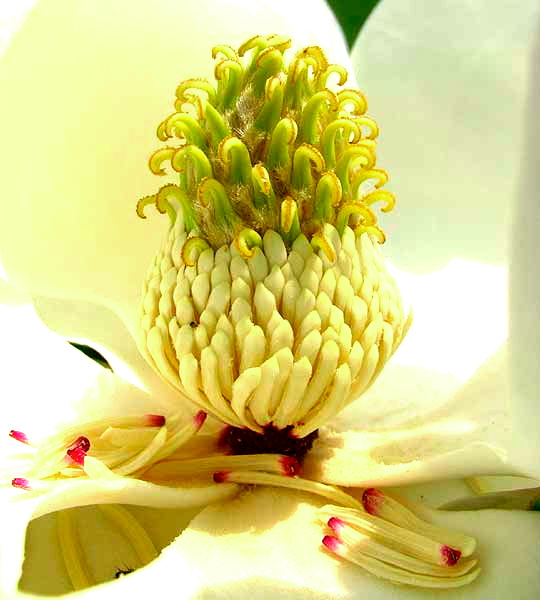Excerpts from Jim Conrad's
Naturalist Newsletter

from the June 3, 2012 Newsletter issued from the woods of the Loess Hill Region a few miles east of Natchez, Mississippi, USA
MAGNOLIAS FLOWERING
When I arrived here the last week in March, already magnolias along the main roads were flowering. Trees here in the wood away from town, however, bore no flowers at all, and just now are reaching their flowering peak. Maybe the early flowering in town and along roads was because of more heat there, or maybe the Highway Department planted a long-flowering cultivar there. Whatever the case, above you can see the amazing blossom of a wild Southern Magnolia, MAGNOLIA GRANDIFLORA, flowering when it's supposed to
That blossom is about eight inches across (20cm) and is issuing into the morning air a dizzying, lemony perfume. The fragrance, the dark green, waxy leaves and those exquisitely structured blossoms all create a unified impression that can be almost overwhelming. Moreover, inside every blossom there's a pineapple-shaped structure somehow evocative of presences you'd expect in an ornate Buddhist temple, as shown below:

At the base of the "pineapple," and scattered around on the blossom's floor, are pollen-producing stamens, the male parts. The greenish, curved items at the top are styles with fuzzy, pollen-collecting stigmatic lines. Together, the stigma, style and ovary are regarded as the female part, the pistil. Below the styles, hidden by the stamens, are ovaries inside which seeds will form. After the blossom is pollinated, the petals and stamens all will fall away, leaving only the maturing cluster of pistils, which eventually will produce a cone-like structure composed of many mature pistils. The mature pistils, referred to at that stage as follicles, will open to release one or two seeds, which for a time will hang suspended from the split follicles on thread-like cords.
Magnolia species arose early in the evolution of flowering plants, even before bees had appeared. Therefore magnolias are adapted for pollination by beetles. One consequence of this is that in the magnolia flower's ovary the compartments holding the future seeds, the carpels, are tough to discourage gnawing beetles. Also, magnolias arose so early that continental drift hadn't yet separated the Earth's land masses into their present configuration, resulting in there being today native magnolia species in Asia as well as North and South America.
Our Southern Magnolia is distributed all through the US Deep South, mostly on the Coastal Plain, from North Carolina to eastern Texas.
from the May 25, 2003 Newsletter issued from the woods of the Loess Hill Region a few miles south of Natchez, Mississippi; elevation ~200ft (~60m), ~N31.42°, ~W91.41°; USA
LIFE IN A MAGNOLIA BLOSSOM
You pass by a magnolia tree -- Southern Magnolia, MAGNOLIA GRANDIFLORA -- and the lemony odor and glossy whiteness of its 8-inch wide blossoms (15 cm), the stateliness of its form, the moist coolness of its shadows... all invite you to step closer.
You draw near a blossom and its perfume makes you dizzy. You choose a young flower with petals just starting to open and a honeybee escapes. "And there's nectar inside as well?" you wonder. You part the petals and stick your face right into everything, probing with your tongue the base of the column of stamens and stigmas, down where the petals arise alternately with one another, and then, yes, after a first sensation of soapy bitterness, there's a hint of sweet nectar, too.
There's a world of business going on there inside the blossom. Tiny, black, slender insects, maybe 1/8th of an inch long (3 mm), with strangely flexible abdomens segmented like cars on a kid's toy train skitter about, clearly upset by your disturbance. They are Rove Beetles of the family Staphylinidae, of which around 3,000 species are found just in the US. Under the handlens you see that Rove Beetles have powerful jaws, and this makes sense, for they mostly feed on other insects.
In fact, these tiny creatures turn out to be the giants of this blossom. Your botherings cause a large number of much smaller, cream-colored, winged beings to come skittering from beneath the clutter of used-up and discarded stamens littering the surface of the tilted flower's lowest petal. With the handlens you can barely see that the skitterers bear the same curious shape as the much larger Rove Beetles, and indeed they may be one of the other 3,000 species. However, they are too small and too fast for a sure identification.
You go to another blossom, this one not yet completely open, but with a worm hole through the middle of one of its petals. Inside the young blossom you find crumbs of pink caterpillar feces, and there's the caterpillar himself, one beautiful enough to live in a magnolia blossom, over an inch long (3 cm) and translucently, almost glowingly, pink. In this all- pale-cream blossom, what magic chemistry resolves itself to such vivid pinkness?
The next blossom is home to roundish mites, and the next one contains a miniscule pink worm curled into the shape of a C inside a droplet of dew. There's also some kind of shield-bug, and blossoms farther along reveal more and more kinds of life, always something new to know and think about.
Like the Earth itself, each magnolia blossom sustains a unique community of self-absorbed beings for whom the blossom amounts to the entire universe.
from the April 27, 2003 Newsletter issued from the woods of the Loess Hill Region a few miles south of Natchez, Mississippi; elevation ~200ft (~60m), ~N31.42°, ~W91.41°; USA
PRIMITIVE MAGNOLIAS
This week the Tulip Poplar's wonderful flowers got me thinking about the relationship, if any, between their special beauty and the fact that, according to the fossil record, analysis of floral structure, and gene sequencing, the Magnolia Family to which the Tulip Poplar belongs has long been regarded as one of the most "primitive" of flowering plants. There were magnolias during dinosaur times about 130 million years ago.
Botanists point to many "primitive characters" exhibited by Magnolia Family members -- for example their woodiness, their simple and alternate leaves, and their showy flowers with long floral axes, poorly developed styles and stigmas, leaf-like stamens, spiral arrangement of parts, and their pistils being separate from one another. ("Modern" families include the sycamores, walnuts, oaks and dogwoods.)
Is there a connection between the beauty of species in the Magnolia Family, and their primitiveness?
About three years ago a shrub called Amborella, found only on the island of New Caledonia in the South Pacific, suddenly became famous. Of all living flowering plants on Earth, it was revealed to be the most closely related to the very first flowering plants. Amborella is not in the Magnolia Family, nor are its flowers particularly large and showy. In habit it's a normal shrub.
So, the magnolias are primitive, but apparently their great beauty isn't closely tied to their primitiveness. I have no regrets about learning this, for the unspoken, unwelcome corollary of the "primitive = beautiful" equation is this: That inevitable evolution perpetually nudges us all toward what is more efficient, but gray; toward what is more productive, but mediocre, and; toward what is more promiscuous, but less vital.
Now that I think about, when I look into the skies at night, or ruminate on the matter of subatomic particles, I find no paradigms in those worlds to support the notion that "primitive = beautiful," and I have to wonder wherever I got that idea. On the other hand, the facts that great things can arise from plain beginnings, and that special beauty can appear anyplace unexpectedly, do fit paradigms glimpsed in the cosmos and in the mathematics of the inner world.
Before, the Magnolia Family's beauty was to me like the beauty of Gauguin's Tahiti paintings. Magnolias seemed to support the idea that being unsophisticated, rustic, elemental -- in and of itself -- was reason enough to explain their beauty. But now I see this: Gauguin's paintings are wonderful not because the Polynesians were simple folk, but because Gauguin was a great artist. Likewise, being primitive doesn't make Earthly things beautiful. What does is the craftsmanship of the Universal Creative Force that produced them.
Step by step old prejudices and assumptions fall away, and new ideas and insights appear and evolve. This week it was the flowering Tulip Poplars who guided me.